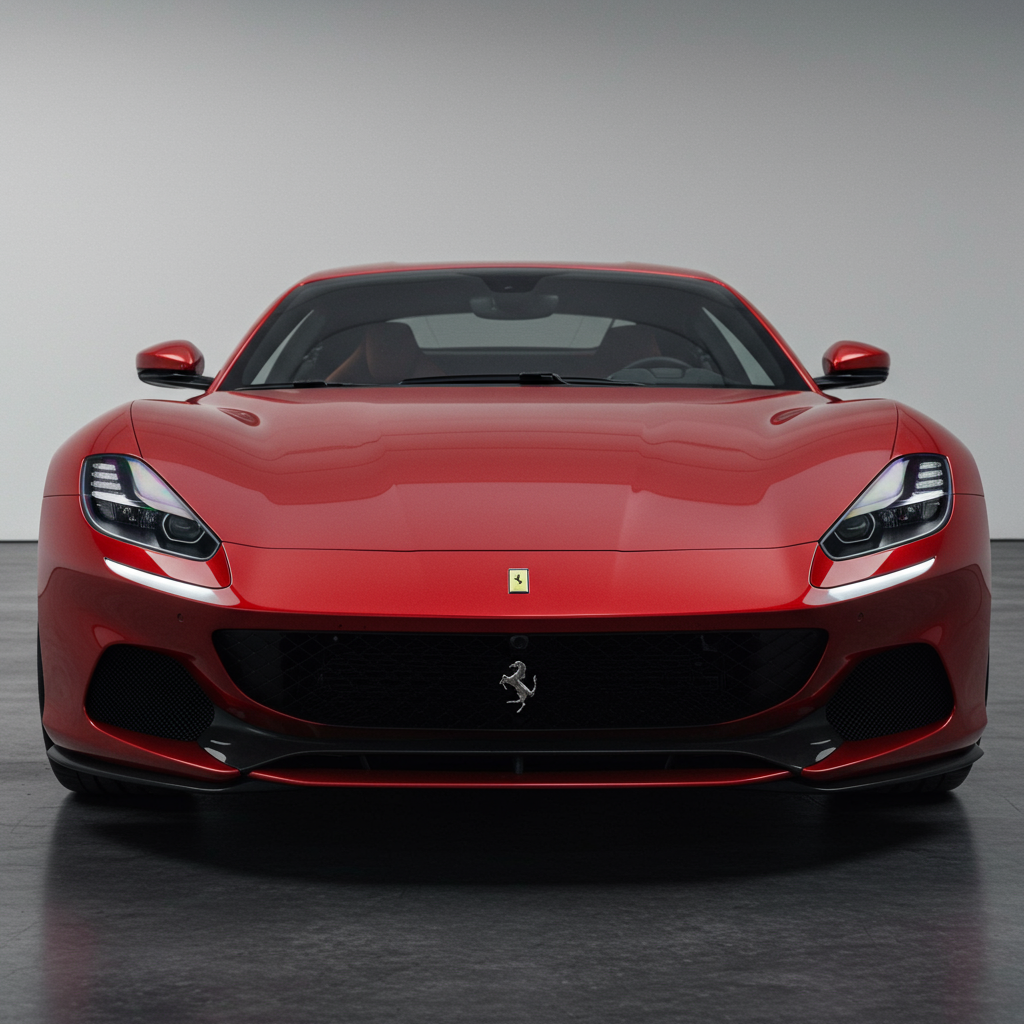Prepare for the next chapter in ferrari‘s GT lineage. Maranello has just pulled the covers off the stunning 2026 Ferrari Amalfi, a front-engined, four-seat coupe poised to step into the shoes of the popular Roma. This newest addition promises to build on its predecessor’s success, particularly in attracting new clients to the iconic brand. While retaining the elegant proportions that defined the Roma, the Amalfi introduces a striking new face, a significantly revised interior addressing key customer feedback, and a potent upgrade to its beloved twin-turbo V8 engine. It’s a pivotal model for Ferrari, blending grand touring comfort with enhanced performance and technology.
Evolving Ferrari Design Language
The 2026 Ferrari Amalfi maintains the graceful, timeless silhouette of the Roma, sharing much of its basic structure and dimensions. However, its exterior styling evolves to align more closely with Ferrari’s current corporate identity. The most noticeable change is the entirely new front fascia. It adopts the distinct “sharknose” design seen on models like the SF90 and 12Cilindri. This includes a sleek black bar connecting the two slimline headlights, giving the car a modern, aggressive gaze.
Subtle revisions continue along the body. The bonnet features a less pronounced hump compared to the Roma. Notably, the “cheesegrater” grille design of the Roma has been removed. At the rear, the Amalfi keeps the signature four distinct taillight pods but adds a connecting black trim piece between the inner lights. Revised underfloor strakes and a tweaked diffuser enhance aerodynamics, improving stability and the downforce-to-drag ratio. An active rear spoiler, spanning the width of the car, deploys at speed to boost downforce.
A User-Focused Interior Revolution
Perhaps the most significant and widely praised update to the Ferrari Amalfi is found within its cabin. Directly responding to customer desires, Ferrari has moved away from the sometimes frustrating touch-capacitive controls that characterized the Roma’s steering wheel and center console. The Amalfi features a welcome return to real, tactile physical buttons on the steering wheel, enhancing usability and allowing drivers to keep their eyes on the road.
Even the engine start-stop function receives this treatment. The touch-capacitive start button has been replaced by a physical button, crafted from lightweight titanium and positioned on the left side of the steering column. This shift aligns with Ferrari’s core driving philosophy and makes ignition a more satisfying, deliberate action. While the passenger display remains, the vertical central infotainment screen of the Roma is replaced by a more conventional horizontal display. This design choice, coupled with a revised dashboard layout, aims to provide a greater sense of space inside the cabin, despite the car’s similar overall dimensions to the Roma.
The Heart of the Beast: Upgraded V8 Power
Powering the 2026 Ferrari Amalfi is an evolution of Ferrari’s highly acclaimed 3.8-liter twin-turbocharged V8 engine. This proven powerplant now delivers even more punch. It’s rated at 631 horsepower, a healthy increase of 19 hp over the outgoing Roma’s 612 hp. Torque output remains robust at 561 pound-feet.
The power bump comes courtesy of several technical refinements under the bonnet. These include lighter-weight camshafts (reducing mass by 1.3kg), a more precisely machined engine block, and the use of lower-viscosity oil. Crucially, changes to the turbocharger’s calibration contribute significantly. Ferrari employs an advanced turbocharging management system allowing independent control of the twin turbochargers. This system, with dedicated calibration and an increased maximum turbo speed of up to 171,000 rpm, improves throttle response and pressure control precision. Dedicated pressure sensors for each cylinder bank further aid this. The engine also benefits from a new control unit previously introduced in models like the 296 GTB, Purosangue, and 12Cilindri, helping unlock its full potential and enabling it to rev faster to its 7600 rpm redline. Intake and exhaust tuning, along with strategic cabin tubing, enhance the engine’s sound character.
Performance and Dynamic Prowess
Connected to the uprated V8 is Ferrari’s familiar and quick-shifting eight-speed dual-clutch transmission. It sends power directly to the rear wheels. Ferrari claims impressive performance figures for the Amalfi. The 0-62 mph sprint is achieved in a mere 3.3 seconds, an improvement of 0.1 seconds over the Roma. Top speed is listed at 198 mph.
Beyond straight-line speed, the Amalfi is engineered for enhanced dynamic capability and refinement. It adopts Ferrari’s advanced ABS Evo brake-by-wire system, first seen on the 296 GTB. This system utilizes a sophisticated 6D sensor to optimize brake force on each wheel with millisecond precision. The car also incorporates Side Slip Control 6.1 software. This acts as a central brain, integrating various vehicle inputs – from steering angle and suspension movement to yaw rate – to continuously deliver optimal grip and performance in any driving scenario, promising a more predictable yet fun experience at the limit. The Manettino dial offers greater distinction between driving modes (Wet, Comfort, Sport, Race, ESC off), allowing for a broader range of capabilities from comfortable cruising to sharper track performance.
Advanced Aerodynamics and Driver Assistance
Aerodynamic efficiency plays a key role in the Ferrari Amalfi’s performance and stability. The new active rear spoiler is a prominent feature. It deploys to different positions based on speed and driving mode. At high speeds, it moves to a mid-position to enhance stability, retracting past 186 mph to minimize drag. During dynamic driving, it adopts a high position, capable of generating 110kg (242 pounds) of downforce at 155 mph with minimal drag penalty.
For enhanced safety and convenience, the Amalfi is equipped with a comprehensive suite of Advanced Driver-Assistance Systems (ADAS). These include features like adaptive cruise control, automatic emergency braking, lane departure warning, lane keep assist, and more. The front fascia design accommodates the necessary hardware for these systems, including the ADAS panel between the headlights. Notably, Ferrari has made the ADAS system simpler to disable for drivers who prefer full manual control on track or in specific driving conditions.
Positioning and Market Context
The 2026 Ferrari Amalfi holds a significant position within the Ferrari lineup. As the replacement for the Roma, it continues the lineage of Ferrari’s front-engined, four-seater GT cars, which have historically served as crucial “entry points” for attracting new customers to the brand. The Roma was highly successful in this role, with roughly half of its buyers being first-time Ferrari owners. The Amalfi is clearly designed to build on this success, offering a more refined and enhanced package that addresses prior criticisms while maintaining the blend of supercar dynamism and GT comfort.
Marketed with a new name rather than simply being a “Roma M” update, the Amalfi aims to stand out. It enters a competitive segment, going head-to-head with formidable rivals such as the Aston Martin DB12, Bentley Continental GT, Maserati GranTurismo, and high-performance variants like the Porsche 911 Turbo S or the upcoming Aston Martin DB12 S. Its expected price point reflects its position as a premium GT.
Availability and Expected Pricing
While Ferrari hasn’t announced exact delivery start dates for the 2026 Amalfi, initial reports suggest production and deliveries could begin before the end of 2025. European markets might see deliveries starting in Q1 2026, with the UK potentially following in Q2 2026. The car is slated for a public display at the 2025 Goodwood Festival of Speed, offering enthusiasts a chance to see it up close.
A convertible version, likely named the Amalfi Spider, is widely anticipated. Given Ferrari trademarked the name last year and the previous Roma Spider arrived about three years after the coupe, the Amalfi Spider might arrive sooner.
Regarding price, the outgoing Ferrari Roma Coupe had a starting price around $247,308. Considering inflation, potential tariffs, and the enhancements offered by the Amalfi, its starting price is expected to be considerably higher. Estimates place the 2026 Ferrari Amalfi’s starting price closer to the $300,000 mark. Ferrari may also introduce a more performance-focused Assetto Fiorano version in the future, following the pattern of previous models.
Frequently Asked Questions
What are the biggest changes on the 2026 Ferrari Amalfi compared to the Roma?
The 2026 Ferrari Amalfi features several key updates over the Roma. Externally, it gets a redesigned front fascia with Ferrari’s latest “sharknose” corporate look and revised rear light trim. Inside, the most significant change is the replacement of frustrating touch-capacitive buttons with physical, tactile controls on the steering wheel and a physical titanium start button. The interior screen layout also shifts from vertical to horizontal. Mechanically, the 3.8L twin-turbo V8 sees a power increase to 631 hp, thanks to engine refinements and advanced turbocharger management, and it gains updated tech like ABS Evo brake-by-wire and an active rear spoiler.
When will the new Ferrari Amalfi go on sale and what will it cost?
Ferrari has indicated that production and deliveries for the 2026 Ferrari Amalfi could potentially start before the end of 2025. Deliveries in specific markets like the UK might begin in Q2 2026. The car will be publicly unveiled at the 2025 Goodwood Festival of Speed. Pricing is not yet officially confirmed, but estimates place the starting price closer to $300,000 in the US, an increase from the Roma’s $247,308 starting price, reflecting inflation and the car’s enhancements.
Does the Ferrari Amalfi still have the V8 engine, and how much power does it make?
Yes, the 2026 Ferrari Amalfi retains Ferrari’s celebrated 3.8-liter twin-turbocharged V8 engine, positioned at the front. This engine has been upgraded for the Amalfi, now producing 631 horsepower. This represents an increase of 19 horsepower over the Roma’s 612 horsepower output. The power boost comes from specific internal engine modifications and a more sophisticated turbocharger control system, enhancing both power and responsiveness while maintaining 561 pound-feet of torque.
Conclusion
The 2026 Ferrari Amalfi emerges as a thoughtfully enhanced successor to the successful Roma. By refining its design, significantly improving the driver interface with the return of physical controls, and boosting the power of its potent V8 engine, Ferrari has created a GT car that promises both increased performance and improved usability. Positioned as a crucial model for attracting new enthusiasts while satisfying loyal customers, the Amalfi is set to continue Ferrari’s legacy of building beautiful, powerful, and engaging grand tourers for the modern era. Its debut signals a promising future for this important segment of the Prancing Horse lineup.




